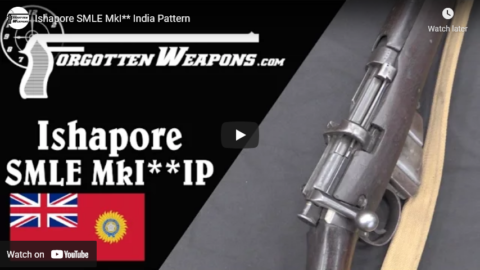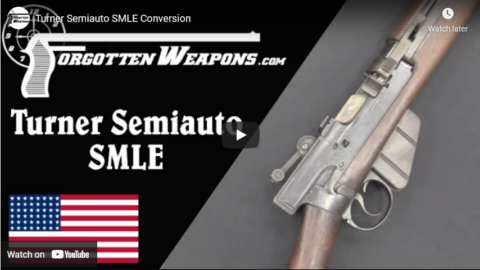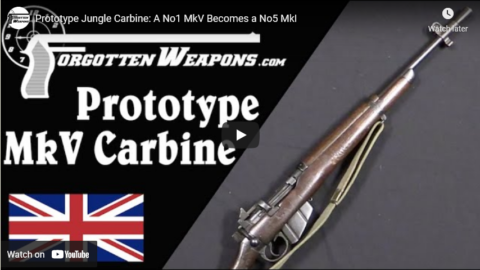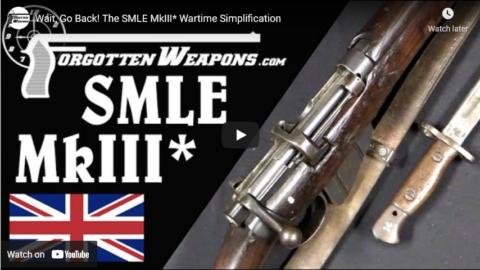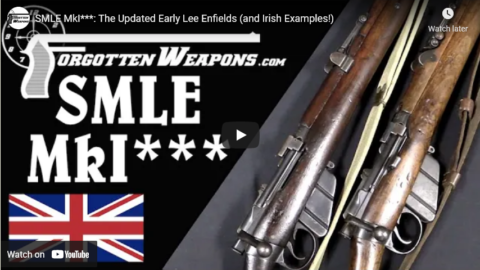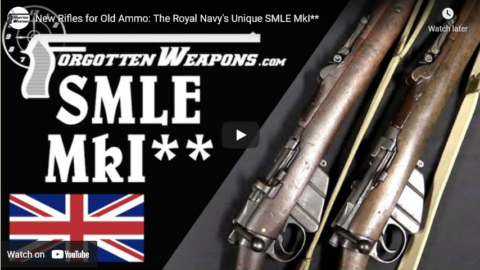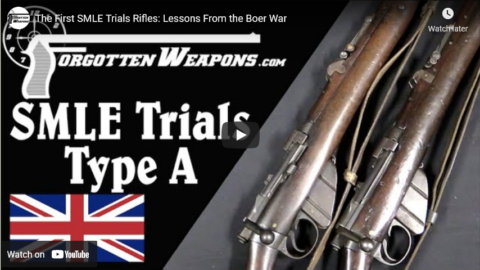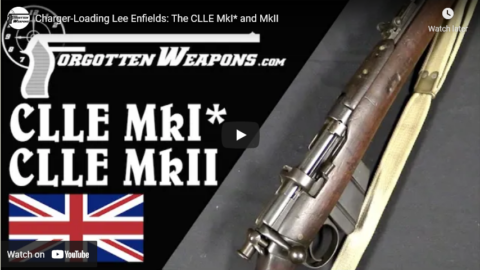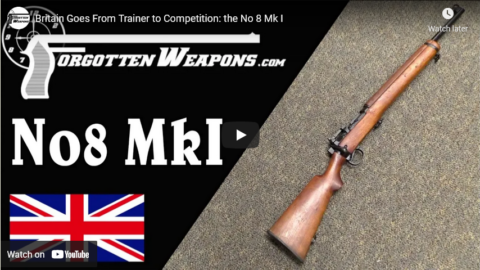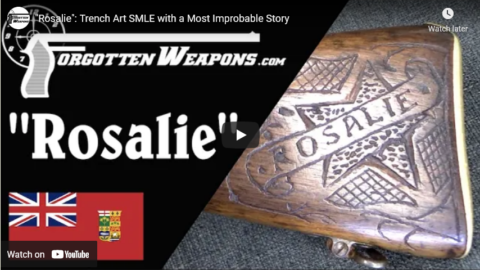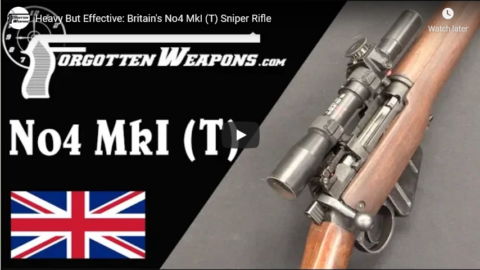Forgotten Weapons
Published 6 Feb 2017While many people are familiar with the Ishapore 2A1 rifles chambered in 7.62mm NATO (largely thanks to their importation and sale in the US in large numbers), production of Indian Enfield rifles actually dates back to 1905, when the Ishapore arsenal was opened. The first rifles produced there were a batch of 3,000 MkI Enfield rifles in 1908/9. These were of course early pattern SMLEs, with features like split charger bridges, volley sights, and magazine cutoffs. Production quickly changed to the No1 Mk III pattern of rifle, which had been formally adopted in Britain in 1907.
During World War One, the need for arms led to those first early rifles being rebuilt in the MkIII configuration, but they retain their original markings, showing their origin. Today we have one of those first 3,000 to look at.
http://www.patreon.com/ForgottenWeapons
Cool Forgotten Weapons merch! http://shop.bbtv.com/collections/forg…
If you enjoy Forgotten Weapons, check out its sister channel, InRangeTV! http://www.youtube.com/InRangeTVShow
September 22, 2021
Ishapore SMLE MkI** India Pattern
September 1, 2021
1893 Lee-Metford Trials Carbine (One of Only 100 Made)
Forgotten Weapons
Published 17 May 2021http://www.patreon.com/ForgottenWeapons
https://www.floatplane.com/channel/Fo…
Cool Forgotten Weapons merch! http://shop.forgottenweapons.com
Once Lee-Metford rifle production was in place, the British began working on a carbine version of the same action for their cavalry. In 1893 a trial run of 100 carbines were made, and today we are looking at serial number 32 of that batch. These carbines are different in several ways from the ultimately adopted pattern. They had exposed muzzles like the Martini carbines, instead of the heavy snub-nose muzzle that would be adopted (similar to the muzzle of most early Mauser carbines). These trials carbines also had no safety, no sling attachments, and no barrel band. The did have the bent bolt handle of the final pattern (albeit not flattened down) and the short 6-round magazine.
Contact:
Forgotten Weapons
6281 N. Oracle 36270
Tucson, AZ 85740
June 21, 2021
Turner Semiauto SMLE Conversion
Forgotten Weapons
Published 12 Nov 2016Cool Forgotten Weapons Merch! http://shop.bbtv.com/collections/forg…
Russell Turner was a Pennsylvania gunsmith and inventor who developed this semiautomatic conversion of an SMLE bolt action rifle circa 1940. It was intended for trial and potential sale to the Canadian military, as it would allow them to retrofit existing rifles into semiautomatic configuration and still use existing supplies of .303 British ammunition. Rather than try to devise a reliable system to rotate the original Enfield bolt, Turner replaced the bolt entirely, using instead a side-tilting design much like what he used in his M1 Carbine trials rifle for the US military. This was coupled with a long stroke gas piston and a hammer firing trigger mechanism.
Reportedly the rifle was tested by Canadian authorities, and performed quite well, with the adjustable gas system allowing it to function reliably even in temperatures of 25 below zero (where the Garand, tested alongside, experienced problems). However, Turner’s rifle was deemed too complex for military adoption.
That decision against the rifle was probably the right one for Canada, although Turner’s conversion is one of the better semi auto bolt acton conversions I have handled. It was remarkably non-awkward — that may not sound like much to crow about, but it sets a pretty high standard for this type of rifle.
May 29, 2021
Prototype Jungle Carbine: A No1 MkV Becomes a No5 MkI
Forgotten Weapons
Published 17 Feb 2021http://www.patreon.com/ForgottenWeapons
https://www.floatplane.com/channel/Fo…
Cool Forgotten Weapons merch! http://shop.bbtv.com/collections/forg…
When the British began developing a shortened version of the No4 Lee Enfield in 1943 (which would become the No5 MkI “Jungle Carbine”), the development process included work with some rather older rifles. What we have here is a 1922 production No1 MkV rifle cut down as a trials prototype for the carbine development program. The No1 MkV was a trials gun itself from the early 1920s which basically gave a rear aperture sight to the classic MkIII SMLE. Unfortunately, I don’t have any specific details on the testing or use of this particular example, but I think it is a fascinating example!
Contact:
Forgotten Weapons
6281 N. Oracle #36270
Tucson, AZ 85740
May 25, 2021
Wait, Go Back! The SMLE MkIII* Wartime Simplification
Forgotten Weapons
Published 10 Feb 2021http://www.patreon.com/ForgottenWeapons
https://www.floatplane.com/channel/Fo…
Cool Forgotten Weapons merch! http://shop.bbtv.com/collections/forg…
The British entered World War One with a technically excellent rifle, with lots of bells and whistles. By 1916, the war was taking a previously unimaginable toll on the industrial capacity of the Empire and rifle production had to be economized. This led to the adoption of the MkIII* pattern of the Lee Enfield, to reduce cost and speed up production. The MkIII* omitted the windage adjustments on the rear sight, the front and rear volley sight elements, and the magazine cutoff. Around the same time, stock discs stopped being stamped with unit information (to avoid giving military intelligence of troop distribution when rifles were captured) and eventually deleted entirely.
The Pattern 1907 bayonet was also changed, although this does not coincide with the MkIII* rifle. In 1913, the British decided to delete the quillon from the standard bayonet. A great many bayonet with quillons were already in service, and those would be used in World War One, although many were modified in the field to cut off the quillons to avoid them hanging up on barbed wire or other obstacles.
Contact:
Forgotten Weapons
6281 N. Oracle #36270
Tucson, AZ 85740
May 18, 2021
SMLE MkI***: The Updated Early Lee Enfields (and Irish Examples!)
Forgotten Weapons
Published 3 Feb 2021http://www.patreon.com/ForgottenWeapons
https://www.floatplane.com/channel/Fo…
Cool Forgotten Weapons merch! http://shop.bbtv.com/collections/forg…
When the British adopted a new high-velocity spitzer bullet for the .303 cartridge, they had to update their rifles to use it. Specifically, the sights had to be recalibrated for the flatter trajectory of the new MkVII ammunition. In addition, the sight picture was changed from a barleycorn front and V-notch rear to the more precise square front post and rear U-notch.
These rifles are quite scarce, but several thousand were brought into the US in the early 1960s as surplus from Ireland. These Irish examples all had new serial numbers applied when the were sent to Ireland by the British in the 1920s, and they are in two different batches (one in MkI*** configuration, and one with the MkIII rear sight). We will take a look at both patterns today as well, so you can see the difference between the much more available Irish type and the pure British version.
Contact:
Forgotten Weapons
6281 N. Oracle #36270
Tucson, AZ 85740
May 5, 2021
New Rifles for Old Ammo: The Royal Navy’s Unique SMLE MkI**
Forgotten Weapons
Published 27 Jan 2021http://www.patreon.com/ForgottenWeapons
https://www.floatplane.com/channel/Fo…
Cool Forgotten Weapons merch! http://shop.bbtv.com/collections/forg…
When the SMLE was adopted by the British, it was to be the new universal rifle for all branches of service, including the Royal Navy. This suited the Navy just fine; they like the features of the new design. However, the Army quickly moved to update their rifles for the new MkVII Spitzer ammunition, and this was an issue. The Navy still had substantial stockpiles of the older round-nose MkVI cartridge, and did not go through it nearly as quickly as the Army. The Navy did not want to simply throw out their ammunition, but the differences in trajectory between the two types of ammunition was substantial. So the Navy opted to adopt its own unique rifle variation, the MkI**. This in effect was the new Army pattern rifle, but with the rear sight still calibrated for the trajectory of MkVI ammunition.
This pattern was first adopted in 1908, using rifles with the then-standard split charger guide. When the fixed charger bridge was adopted, the Navy (which still had plenty of MkVI ammunition) chose to update its MkI** rifles to fixed charger bridges, without making any change to their designation. Once they finally ran out of the older ammunition during World War One, the rifles were updated once again to what was then the standard MkI*** pattern. As a result, intact MkI** rifles — especially ones with the split charger guide — are extremely rare to find today. Many thanks to the owner of these two specimens for giving me access to share them with you!
Contact:
Forgotten Weapons
6281 N. Oracle #36270
Tucson, AZ 85740
May 1, 2021
SMLE MkIII: The Iconic Smelly of World War One
Forgotten Weapons
Published 20 Jan 2021http://www.patreon.com/ForgottenWeapons
https://www.floatplane.com/channel/Fo…
Cool Forgotten Weapons merch! http://shop.bbtv.com/collections/forg…
In 1907, the British adopted the final major pattern in the evolution of the Short, Magazine, Lee Enfield. Designated the ShtLE MkIII (Short Lee Enfield) at the time, it would be retroactively renamed Rifle No1 MkIII in the 1920s. This new design was simpler and more durable than its predecessors while actually improving the practical accuracy of the rifle. The rear sight protector wings were substantially strengthened, the front sight became a square post, the front sight protectors were opened up to allow more light in, and the rear sight windage adjustment was simplified — while retailing 1 MOA adjustment clicks and 25m elevation adjustments. A new bayonet was also adopted in 1907 for the MkIII. The previous 1903 pattern bayonet was deemed too short, and the British essentially copied the Japanese Type 30 Arisaka bayonet as its new Pattern 1907 — hooked quillion and all.
The example we are looking at in today’s video is a fantastic specimen, as it was sold out of service to an Australian reservist in 1912 having not received any post-production modifications or updates. It is still sighted for the early MkVI round-nose ammunition, for example, and its bayonet retains the hooked quillion. The rifle’s owner died prior to World War One, and the gun remained stored away and forgotten through both World Wars, where virtually all existing service rifles were taken back into service and updated. Only in the 1960s was this one found, making it a pristine collector’s example to show how the MkIII was originally produced.
Contact:
Forgotten Weapons
6281 N. Oracle #36270
Tucson, AZ 85740
April 25, 2021
The First SMLE Trials Rifles: Lessons From the Boer War
Forgotten Weapons
Published 13 Jan 2021http://www.patreon.com/ForgottenWeapons
https://www.floatplane.com/channel/Fo…
Cool Forgotten Weapons merch! http://shop.bbtv.com/collections/forg…
In the aftermath of the Boer War, the British military needed to address critical issues of practical marksmanship with its troops. The Long Lee rifles it had deployed to South Africa suffered significant problems in making real-world hits on the battlefield. In addition to investing in better musketry training, the military chose to radically change its rifles.
In place of the Lee rifles and carbines, a single short rifle pattern would be issued for all branches of service (cavalry, artillery, and infantry). A stripper clip loading system was introduced to speed reloading and a full-length handguard for improving bayonet handling and reducing sight mirage. A windage adjustable rear sight was mandated, and a stout full protective hood added around the front sight. A new nosecap design was implemented to put the weight of the bayonet onto the stock, and not on the barrel where it would impact the rifle’s zero.
Two different patterns of rear sight were considered. The A pattern design was a tangent type sight like a Mauser, pinned at the front. The B pattern used a ladder sight, pinned at the rear. Five hundred of each were made, and put through a rigorous set of remarkably practical field trials. The testing involved not just static shooting for accuracy, but also shooting against timed disappearing targets, camouflaged targets, and snap shooting. The trial winner was the A pattern design, and it went into mass production in 1904 as the Short, Magazine, Lee Enfield Mark I — the first SMLE.
As adopted a few minor changes were made from the trials rifles, most notably a change from a full front sight hood to a pair of stout protective wings, to allow more light onto the sight. In addition, the design was almost immediately updated to a MkI* pattern, with a stronger rear sling swivel, rounded corners on the receiver, and a storage trap added to the buttplate.
Contact:
Forgotten Weapons
6281 N. Oracle #36270
Tucson, AZ 85740
April 22, 2021
Charger-Loading Lee Enfields: The CLLE MkI* and MkII
Forgotten Weapons
Published 6 Jan 2020http://www.patreon.com/ForgottenWeapons
https://www.floatplane.com/channel/Fo…
Cool Forgotten Weapons merch! http://shop.bbtv.com/collections/forg…
In our continuing series on the development of the British Lee Enfield rifles, we are looking at the CLLE conversions today. In 1907 the British adopted a new universal short rifle (the SMLE) that used charger (aka stripper) clips. Previous models of the Lee in British service had to be loaded one round at a time by hand. In order to make use of the hundreds of thousands of “Long Lee” (and Metford) rifles already manufactured, the British instituted a program to update them with charger guides. The began in 1908 and ran to 1914, although the majority were done in 1909 and 1910. In addition to removing the dust cover and fitting the charger guide, the front sight, rear sight, magazine, and volley sights were all updated. The new sights were windage-adjustable on both front and rear, and calibrated for Mk VI ammunition (although many were later updated again and re-re-calibrated for Mk VII ammunition).
These CLLE rifles would serve as second-line rifles in World War One and even through the end of World War Two.
Contact:
Forgotten Weapons
6281 N. Oracle #36270
Tucson, AZ 85740
April 15, 2021
Britain Goes From Trainer to Competition: the No 8 Mk I
Forgotten Weapons
Published 18 Jun 2018http://www.forgottenweapons.com/brita…
http://www.patreon.com/ForgottenWeapons
Cool Forgotten Weapons merch! http://shop.bbtv.com/collections/forg…
Initially intended to be used only by the British Army (the Land Service), in 1950 the No8 rifle’s role was expanded to cover all three services. Unlike the other trainers made up to this point, the No8 MkI was designed as a target and competition rifle, instead of a service rifle reduced in caliber. It has a heavy barrel, a nice trigger converter to cock on open, and a heavy competition type stock. Adopted in 1948 or 1949 (sources differ), a whopping 76,000 were ordered and manufactured by BSA and Fazackerly — they remained in service until finally declared obsolescent by the British in 2014.
If you enjoy Forgotten Weapons, check out its sister channel, InRangeTV! http://www.youtube.com/InRangeTVShow
Contact:
Forgotten Weapons
6281 N Oracle #36270
Tucson, AZ 85704
April 10, 2021
Britain’s Only Repeating Enfield Trainer: the No7 Mk I
Forgotten Weapons
Published 12 Jun 2018http://www.forgottenweapons.com/brita…
http://www.patreon.com/ForgottenWeapons
Cool Forgotten Weapons merch! http://shop.bbtv.com/collections/forg…
Developed by BSA immediately after World War Two, the No7 MkI training rifle was the only one of the British Enfield trainers to use a magazine. Only 2500 of these rifles were produced, contracted by the Royal Air Force and delivered in 1948. Their magazine is a commercial BSA 5-round magazine modified slightly to latch into a housing inside a regular No4 Enfield magazine body. This makes them a particularly enjoyable rifle for range shooting, as well as one of the scarcest of the standard British trainers.Note that Canada also developed and adopted a No7 MkI .22 rimfire trainer, but that type is a single shot design, and does not share any parts with the British No7 MkI.
If you enjoy Forgotten Weapons, check out its sister channel, InRangeTV! http://www.youtube.com/InRangeTVShow
Contact:
Forgotten Weapons
6281 N Oracle #36270
Tucson, AZ 85704
April 7, 2021
Britain’s First Standard Trainer: the No 2 Mk IV*
Forgotten Weapons
Published 6 Jun 2018http://www.forgottenweapons.com/brita…
http://www.patreon.com/ForgottenWeapons
Cool Forgotten Weapons merch! http://shop.bbtv.com/collections/forg…
The British military started using training rifles in 1883, with the .297/.230 Morris cartridge in adapted Martini rifles. This would give way to the .22 rimfire cartridge for training shortly after the Boer War, and a substantial variety of rifles converted to .22 rimfire. Standardization would take until 1921, when the “Rifle, short, .22 inch, RF, Mk IV” was formally adopted – a conversion of the No1 MkIII SMLE to a single shot .22 rimfire weapon. This was modified to Mk IV* in 1925, when an empty magazine body was added to the rifle, to act as a brass catcher.
Just to make things more confusing, the nomenclature system was retroactively changed in 1926, and the designation became Rifle, No2 Mk IV*. This rifle is a very simple conversion. It used a standard bolt body, with the striker and bolt head modified for a rimfire type firing pin and .22 caliber extractor. The sight was not even changed; instead a conversion chart was issued with the rifles to specify the proper sight settings for .22 rimfire shooting (ie, set sight to 300yd for shooting at 25yd). These rifles would be used into the 1950s, particularly by India and Australia, who did not produce No4 rifles and thus did not produce No4 trainer conversions either.
If you enjoy Forgotten Weapons, check out its sister channel, InRangeTV! http://www.youtube.com/InRangeTVShow
Contact:
Forgotten Weapons
6281 N Oracle #36270
Tucson, AZ 85704
March 31, 2021
“Rosalie”: Trench Art SMLE with a Most Improbable Story
Forgotten Weapons
Published 21 Dec 2020http://www.patreon.com/ForgottenWeapons
https://www.floatplane.com/channel/Fo…
Cool Forgotten Weapons merch! http://shop.bbtv.com/collections/forg…
Henri Lecorre was a French immigrant to Canada who enlisted in the 22nd Regiment of the Canadian Army in April, 1915. He had a knack for carving things in his rifles, which he started right in basic training, with a Ross rifle he named “Josephine”. That got him sternly rebuked by his Colonel, but he would take up the habit again in 1916 when he arrived in France and began to see combat. At this point the Canadians were issuing SMLE rifles, and Lecorre named his “Rosalie”, after the French bayonet’s nickname.
Lecorre served through 14 major campaigns, and carved each name into his rifle as the years of the war dragged on. He was twice caught and punished for destruction of government property and fined for the cost of the rifle, although he managed to avoid more serious punishment both times. He only embellished the left side of Rosalie, so that his work would be hidden against his leg when standing at attention. By the summer of 1918, Rosalie’s service record included Vimy, Kemmel, St. Eloi, Hoodge, Zellebeck, Courcelette, Bully Grenay, Neuvilles Vaade, Mericour, Lievin, Lens, Cote 70, Passchendaele and Arras.
Fate eventually caught up to Private Lecorre, and in mid-1918 he was seriously wounded in an attack, and woke up in a military hospital in Dieppe. Rosalie was long gone, and Lecorre did not return to combat again.
The story is far from over, however. Rosalie was recovered from the battlefield, and sent back to Enfield with a batch of damaged rifles for refurbishment and reissue. Someone in the factory noticed the carving on it, and it was set aside. The arsenal commander took a liking to it, and it was hung in his office — where it remained for some 30 years. A Canadian officer from the 22nd Regiment noticed it at Enfield — thanks to Lecorre carving his unit’s name into it — during the Second World War, and thought it would be appropriate to return it to the unit’s home town, where the Citadelle Museum was established in 1950, with Rosalie as one of its original exhibits.
In 1956, Lecorre himself happened to visit an exhibition near Quebec City where the museum had set up, and was shocked to see his own Rosalie on display. After some understandable difficulty convincing the officer on duty that it was actually *his* rifle (which Lecorre did by reciting back its serial number unseen), a remarkable reunion took place. The rifle remained with the museum, but now with its full story known. It remains there to this day, on permanent display.
The Citadelle Museum commissioned a reproduction of Rosalie to be used for demonstrations, and it is this rifle which was graciously made available to me for filming, as the original is inaccessible on short notice because of its display case. Many thanks to the Citadelle for the opportunity to present it to you! If you are in Quebec City, make sure to take time to visit them:
https://www.lacitadelle.qc.ca/en/
Contact:
Forgotten Weapons
6281 N. Oracle #36270
Tucson, AZ 85740
March 17, 2021
Heavy But Effective: Britain’s No4 MkI (T) Sniper Rifle
Forgotten Weapons
Published 29 Aug 2018http://www.patreon.com/ForgottenWeapons
Cool Forgotten Weapons merch! http://shop.bbtv.com/collections/forg…
The main British sniper rifle of World War Two, and arguably one of the best looking military sniper rifles of all time, the No4 MkI (T) was something the British military knew they would want even before the No4 MkI rifle had gone into real production. The first No4 snipers were built on leftover trials rifles from Enfield, and the pattern was formally introduced in February of 1942. First use was in North Africa, but the fighting there was not really suited to sniper rifles, and the weapon’s practical combat debut was in Italy in 1943.
The No4 MkI (T) was a conversion of a standard No4 MkI rifle, using examples chosen for particular good accuracy. They were sent to Holland & Holland to have scope mount bases added and No32 telescopic sights fitted (along with cheek risers on the stocks and having the battle sight aperture ground off to allow room for the scope bell). Between 23,000 and 26,000 were made during the war, and they would continue to be used in the British military for decades, including later conversion into 7.62mm NATO L42A1 rifles [which Ian discusses here].
Contact:
Forgotten Weapons
6281 N Oracle #36270
Tucson, AZ 85704

